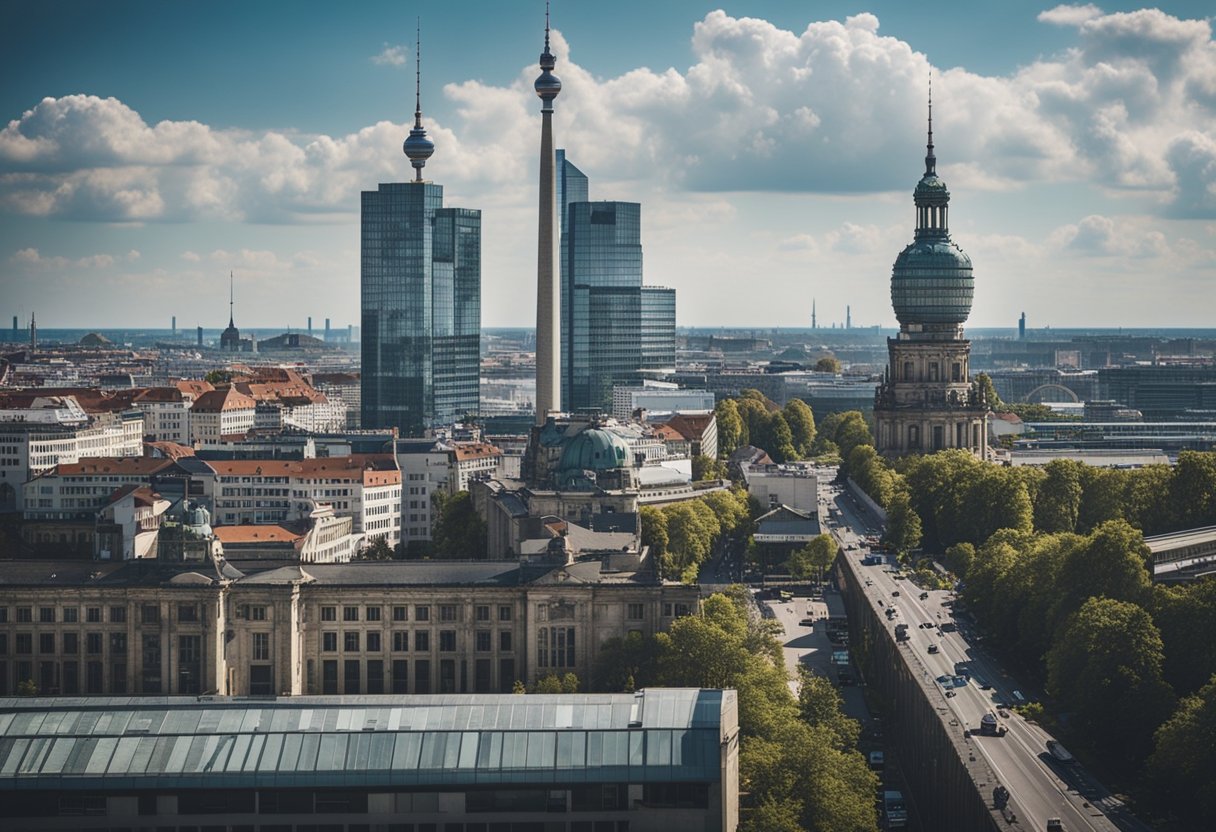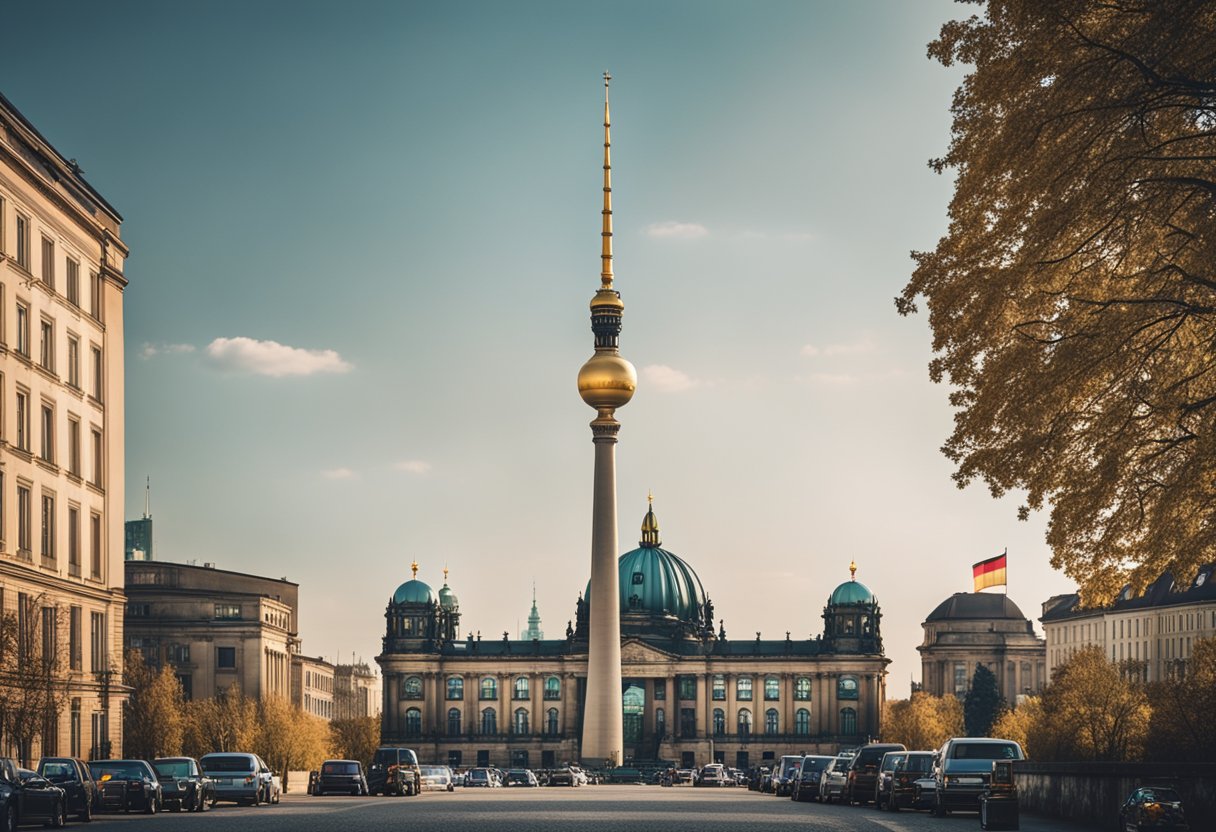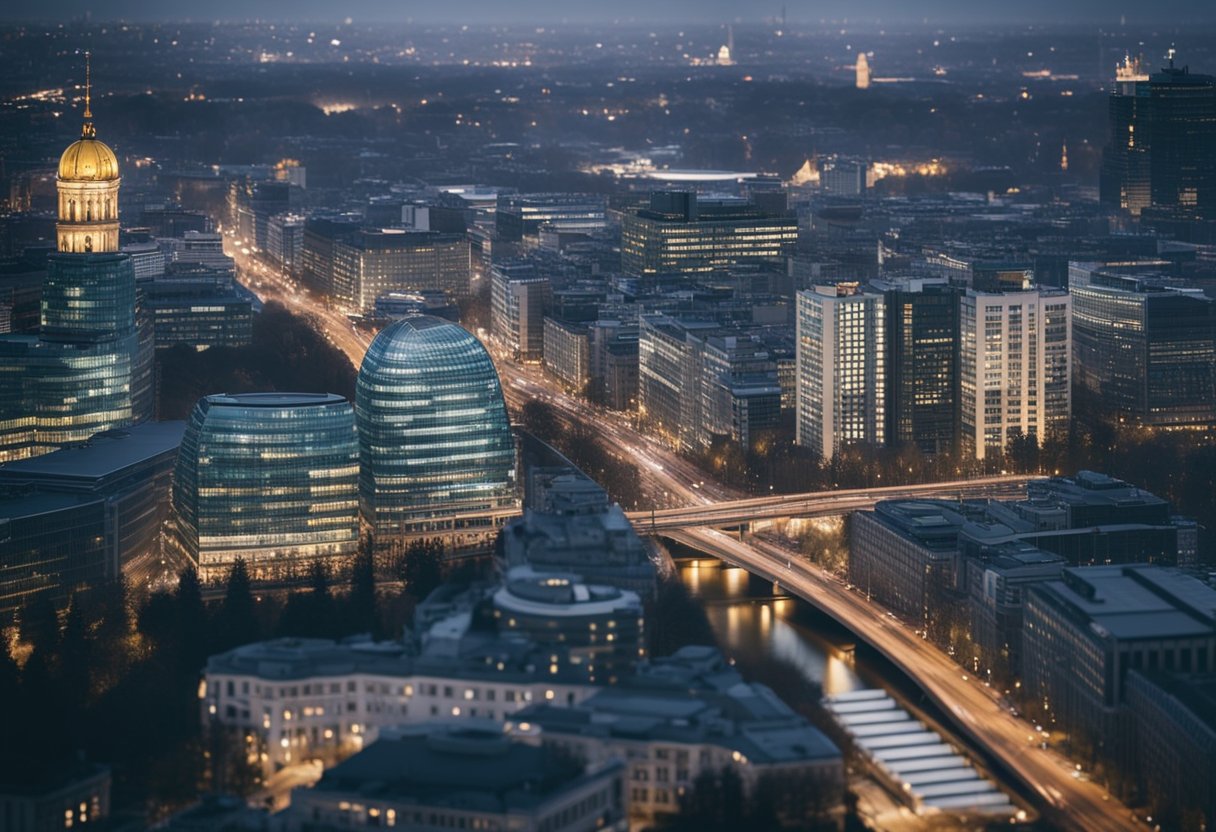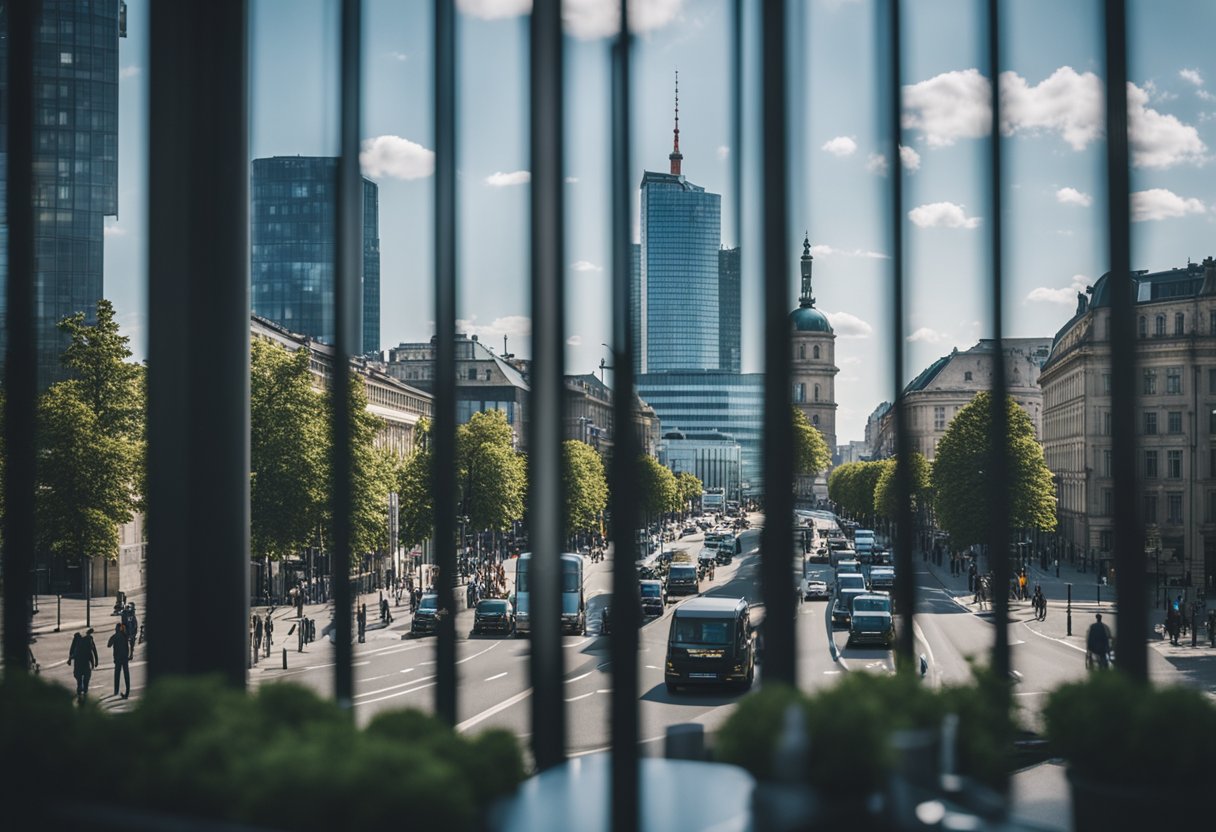Economy of Berlin, Germany’s capital city, stands as a vibrant hub of economic activity within the nation and across Europe.
With a diverse economic structure, Berlin has evolved from a city once heavily reliant on manufacturing and industry to one dominated by the service sector.
The vibrant metropolis boasts a complex and dynamic economy with a significant concentration on service-oriented businesses, comprising about 84% of all employment.
This shift aligns with global trends, where megacities increasingly become centers for innovation, technology, and services.
Among the key drivers of Berlin’s economy, the creative industries, research, and tourism have played substantial roles.
The city is a fertile ground for start-ups and business founders, drawn by the conducive environment for innovation and entrepreneurship.
Additionally, tourism continues to contribute significantly to the local economy, with Berlin’s rich historical and cultural offerings attracting visitors globally.
The manufacturing sector, though smaller than in the past, still includes robust niches in the production of high-quality goods ranging from electronics to pharmaceuticals.
As of recent assessments, Berlin’s economic output demonstrates robust growth, with gross domestic product (GDP) indicators illustrating an upward trend that surpasses the national average in Germany.
The city’s GDP per capita also reflects the economic prosperity and the higher standard of living experienced by its residents.
Berlin’s economic development initiatives persist in fostering a supportive environment for businesses, focusing on sustainability and innovation, ensuring that the city remains at the forefront of Germany’s economic landscape.
Historical Development of Berlin’s Economy
The economy of Berlin has undergone profound transformations, shaped by historical events like World War II, the division during the Cold War, and German reunification. These changes have transitioned Berlin from an industrial focal point to a modern service-oriented hub.
Impact of World War II and German Reunification
World War II wrought devastating damage on Berlin’s infrastructure and industrial capacity, leading to a period of significant economic hardship.
Following the war, the city was divided, which further complicated economic development. However, after German reunification in 1990, a process of rebuilding commenced. Funds were allocated to modernize the infrastructure, and the city began to attract new businesses, hastening economic recovery.
Transition from Industrial to Service Sector
The city’s economy evolved notably from manufacturing to services. Throughout the 20th century, Berlin saw a decline in industrial jobs with a corresponding rise in the service sector. Today, industries such as information technology, media, and tourism are significant contributors to Berlin’s GDP, underscoring the shift to a knowledge-based economy.
Influence of the Cold War on East Germany
The Cold War had a profound effect on the economic landscape of East Germany, including East Berlin. As part of the socialist economic system, the East German economy was centrally planned, and industries were state-owned.
The fall of the Berlin Wall and subsequent unification brought about the integration of East Germany into the Federal Republic of Germany’s market economy, leading to the privatization and modernization of industries, significant investment in infrastructure, and overall economic growth.
Current Economic Landscape
Berlin’s economy is experiencing robust growth with significant contributions from the service sector and advancements in research and development. This capital city stands as a hub for innovation, which complements its traditional industrial production.
Service Sector Dominance
The service sector in Berlin constitutes a predominant force in the city’s economy, comprising approximately 84% of all companies performing services. These range from information technology, creative industries, to healthcare and education.
With a substantial share, the service sector is a primary driver of economic expansion, cementing Berlin’s role as a thriving economic center in Germany.
Industrial Production and Manufacturing
Despite the service sector’s prominence, industrial production and manufacturing retain a significant place in Berlin’s economic fabric. Specialized manufacturing, especially in the sectors like pharmaceuticals, renewable energy, and the production of electronics, form vital components of the industrial landscape.
This sector has evolved to focus on high-value products, leveraging the city’s skilled workforce and advanced technology.
Innovation and Research and Development
Berlin is at the forefront of innovation and research and development (R&D), with a burgeoning startup scene that attracts both domestic and international investments.
The city’s R&D efforts are supported by numerous technology parks and research institutions, fostering innovation across various fields such as biotechnology, medical research, and environmental services. This culture of innovation sustains Berlin’s economic vitality and positions it as a competitive player on the global stage.
Government and Economic Policies
Berlin’s economy has experienced both challenges and growth influenced by government economic policies. Amid economic fluctuations, the government and coalition have undertaken measures to mitigate the impact of the Corona pandemic while managing structural changes and budget allocations.
Federal and Coalition Support Measures
The German government, in coalition with state authorities, has deployed various strategies to support businesses and stabilize the economy during the Corona pandemic.
Measures have included financial aid packages, tax relief, and incentives to maintain employment levels. These interventions are critical to safeguard the city’s service-oriented economic fabric, which constitutes approximately 84% of all companies.
Economic Impact of the Corona Pandemic
The pandemic’s economic ramifications have been significant, with reduced productivity and strained public resources. Despite this, Berlin’s GDP grew by 4.9% in 2022, showing resilience and capacity for recovery.
However, the pandemic has also caused underutilization of capacities and global supply bottlenecks, impacting domestic production.
Structural Changes and Budget Management
Berlin’s government, adhering to constitutional court mandates, has had to adapt its budget management strategies to address the budget crisis sparked by the pandemic.
Structural changes have focused on digitalization and sustainable development to future-proof the economy. These changes aim to enhance Berlin’s competitiveness, evidenced by a GDP that’s higher than the pre-pandemic year 2019, while staying within fiscal constraints.
Economic Indicators and Statistics
Economic performance in Berlin is closely monitored through a range of indicators and statistics, providing insight into the health of its economy. This section explores various dimensions of Berlin’s economic landscape.
Gross Domestic Product and Economic Output
Berlin’s gross domestic product (GDP) is a strong indicator of its economic health. The city has experienced substantial growth in recent years. Economic output has risen significantly, with Berlin’s GDP growing by 4.9 percent in 2022, which is above the German national average.
Employment and Unemployment Rates
Employment levels in Berlin are reflective of its diverse economic sectors, ranging from high-tech industries to creative enterprises. Unemployment rates have fluctuated over time, but efforts in economic development aim to stabilize and improve employment opportunities.
Comparison to National and European Metrics
Berlin stands as an influential economy within Germany and Europe. Its economic performance tends to be contrasted with national metrics, often displaying a strong position in nationwide comparisons. Berlin’s growth rates and GDP per capita also highlight its role in the broader European economic context.
Business and Investment Environment
Berlin’s economy has demonstrated resilience and adaptability, emerging robustly from global challenges to foster a climate ripe for business and investment. The city presents a compelling mix of innovation and established industry, creating a dynamic environment for both new and existing players.
Attractiveness as a Business Location
Berlin is highly regarded as a competitive business location, attracting a diverse array of industries. The city’s economic backbone is formed by a service sector that comprises around 84% of its companies, alongside flourishing high-tech and creative industries.
According to Berlin.de, the capital possesses a vibrant ecosystem of industrial firms, medium-sized enterprises, and startups, ensuring continued growth in future-focused sectors.
Growth of New Jobs and Companies
The metropolis has become a hotbed for new jobs and company growth. Job creation keeps pace with economic expansion, with employment figures and gross domestic product (GDP) consistently outperforming national averages.
In recent years, Berlin’s GDP has shown significant year-on-year growth, signaling an environment where companies can thrive and contribute to the city’s prosperity.
Foreign Investments and Economic Competitiveness
Foreign investments play a substantial role in Berlin’s economic competitiveness on the global stage, driving innovation and fostering a diverse business landscape.
Berlin stands as Germany’s second-highest region for growth rate when compared nationally, a testament to its increasing economic power conveyed by the Business Location Center.
This is indicative of a healthy investment climate that continues to attract international stakeholders and nurtures Berlin’s status in the global marketplace.
Sector-Specific Insights
Berlin’s economy showcases a dynamic range of sectors that contribute significantly to its growth, from robust construction efforts to an expanding transportation network and a vibrant retail scene buoyed by increasing tourism.
Construction and Infrastructure
The construction sector in Berlin is instrumental in shaping the city’s evolving skyline and is seen as a key economic driver.
Ongoing development projects, such as the Berlin Brandenburg Airport, reflect an emphasis on expanding the city’s infrastructure. Investments in residential and commercial construction continue to rise in response to Berlin’s growing population and economic demands.
Transportation and Deutsche Bahn
Transportation in Berlin is a vital industry, with the city being a central hub for rail and road networks. Deutsche Bahn, Germany’s main railway operator, has its headquarters in Berlin and plays a crucial role in the connectivity of the city.
With extensive railway redevelopment plans, there is a focus on enhancing both local and long-distance transport services to support Berlin’s economy.
Tourism and Retail Sales
Berlin’s appeal as a tourist destination has a direct and positive impact on its retail sales. The influx of visitors stimulates demand in both the tourism sector and retail markets, with notable growth statistics in recent years.
Specialty shops, international retailers, and local businesses all benefit from the steady stream of tourists, shaping a dynamic and resilient retail sector.
Challenges and Future Outlook
Berlin’s economy faces pressing challenges including an energy crisis and a shortage of skilled labor. Efforts toward sustainable development remain a key focus. The path to economic recovery requires navigating these complexities effectively.
The Energy Crisis and Economic Recovery
Berlin, as part of Germany, is grappling with an energy crisis that has impacted its economic stability. The city’s growth rate is inherently linked to its ability to secure energy for businesses and residents. Initiatives are underway to foster economic recovery, with policies focusing on diversifying energy sources and increasing energy efficiency.
- Diversification of Energy Sources: Exploring renewable energy alternatives to mitigate the reliance on traditional fuels.
- Energy Efficiency Measures: Implementing new technologies to reduce energy consumption within the industrial sector, which is a backbone of Berlin’s GDP.
Labor Market Conditions and Specialist Shortage
The labor market in Berlin is experiencing a shortage of specialists, crucial for the city’s tech-driven economic landscape. This specialist gap hinders potential growth, emphasizing the need for educational reforms and incentives to attract skilled workers.
- Tech Industry Needs: Increasing demand for IT and tech specialists to sustain Berlin’s tech startups and established tech firms.
- Educational Reforms: Expanding vocational training and higher education programs tailored to current market needs.
Environmental Concerns and Sustainable Development
Sustainable development is imperative for Berlin, which has committed to substantial reductions in carbon emissions. Environmental policies are expected to shape the future of all sectors within Berlin’s economy.
- Climate Goals: Aiming to reduce emissions by 65% below 1990 levels by 2030.
- Green Infrastructure: Investment in green transportation and energy-efficient buildings to drive sustainable urban development.
The city’s economic blueprint includes bolstering its position as a center for innovation and creative industries, along with maintaining its reputation for cultural and tourism appeal. Despite the current challenges, Berlin’s economy has the capacity to adapt and grow, with projected increases in GDP per capita signaling positive momentum.
Frequently Asked Questions
Berlin’s economy is notable for its rapid growth, with significant contributions from the technology sector and a strong emphasis on the service industry.
What are the key sectors driving the economy of Berlin?
The economy of Berlin is primarily powered by the service sector, including high-tech industries, research and development, creative industries, and tourism. A substantial portion of the city’s revenue comes from these sectors, signifying their prominence in Berlin’s economic matrix.
How has Berlin’s GDP per capita changed in recent years?
Berlin has experienced a remarkable increase in GDP per capita, showcasing economic growth that outpaces many other regions in Germany. Economic development reports suggest consistent year-on-year growth, reflecting a healthy and expanding economy.
What impact has the technology industry had on Berlin’s economic growth?
The technology industry in Berlin has been a major catalyst for economic expansion, establishing the city as a hub for startups and innovation within Germany and Europe. The influx of tech companies has substantially contributed to the job market and economic power of the capital.
How does Berlin’s economy compare to that of other major German cities?
Compared to other major German cities, Berlin’s economy stands out for its dynamic growth and diverse industry profile. While traditionally lagging behind in terms of GDP per capita, recent years have seen Berlin rapidly closing this gap, buoyed by its burgeoning service and creative sectors.
In what ways has the history of the Berlin Wall affected the city’s economic development?
The history of the Berlin Wall has profoundly shaped Berlin’s economic landscape, initially creating division but eventually fostering a unique cultural and economic dynamism post-reunification. This tumultuous past has given rise to a vibrant and innovative business environment that capitalizes on the city’s unique historical experiences.
What role does tourism play in the economic landscape of Berlin?
Tourism plays a significant role in Berlin’s economy, attracting visitors worldwide due to its rich history, cultural landmarks, and diverse modern attractions. The revenue generated from tourism contributes substantially to the local economy, supporting businesses across various sectors and augmenting the city’s international appeal.





